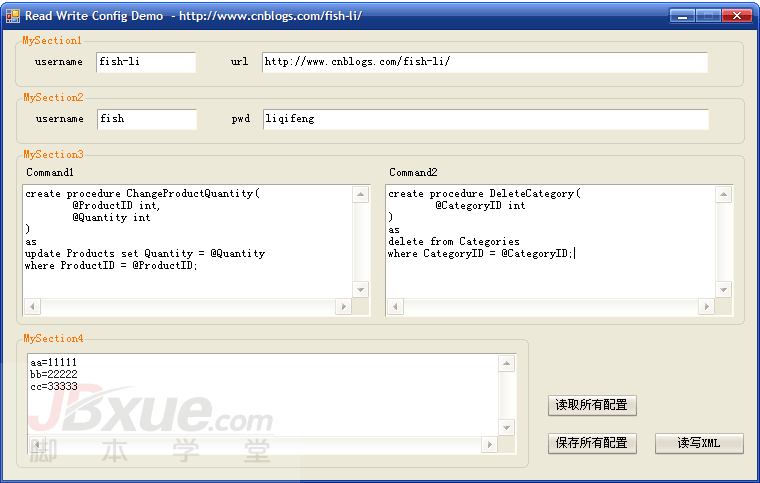今天谈谈在.net中读写config文件的各种方法。 在这篇博客中,我将介绍各种配置文件的读写操作。 由于内容较为直观,因此没有过多的空道理,只有实实在在的演示代码, 目的只为了再现实战开发中的各种场景。希望大家能喜欢。
通常,我们在.NET开发过程中,会接触二种类型的配置文件:config文件,xml文件。 今天的博客示例也将介绍这二大类的配置文件的各类操作。 在config文件中,我将主要演示如何创建自己的自定义的配置节点,而不是介绍如何使用appSetting 。
请明:本文所说的config文件特指app.config或者web.config,而不是一般的XML文件。 在这类配置文件中,由于.net framework已经为它们定义了一些配置节点,因此我们并不能简单地通过序列化的方式去读写它。
回到顶部
config文件 - 自定义配置节点
为什么要自定义的配置节点?
确实,有很多人在使用config文件都是直接使用appSetting的,把所有的配置参数全都塞到那里,这样做虽然不错, 但是如果参数过多,这种做法的缺点也会明显地暴露出来:appSetting中的配置参数项只能按key名来访问,不能支持复杂的层次节点也不支持强类型, 而且由于全都只使用这一个集合,你会发现:完全不相干的参数也要放在一起!
想摆脱这种困扰吗?自定义的配置节点将是解决这个问题的一种可行方法。
首先,我们来看一下如何在app.config或者web.config中增加一个自定义的配置节点。 在这篇博客中,我将介绍4种自定义配置节点的方式,最终的配置文件如下:
<?xml version="1.0" encoding="utf-8" ?>
<configuration>
<configSections>
<section name="MySection111" type="RwConfigDemo.MySection1, RwConfigDemo" />
<section name="MySection222" type="RwConfigDemo.MySection2, RwConfigDemo" />
<section name="MySection333" type="RwConfigDemo.MySection3, RwConfigDemo" />
<section name="MySection444" type="RwConfigDemo.MySection4, RwConfigDemo" />
</configSections>
<MySection111 username="fish-li" url="http://www.cnblogs.com/fish-li/"></MySection111>
<MySection222>
<users username="fish" password="liqifeng"></users>
</MySection222>
<MySection444>
<add key="aa" value="11111"></add>
<add key="bb" value="22222"></add>
<add key="cc" value="33333"></add>
</MySection444>
<MySection333>
<Command1>
<![CDATA[
create procedure ChangeProductQuantity(
@ProductID int,
@Quantity int
)
as
update Products set Quantity = @Quantity
where ProductID = @ProductID;
]]>
</Command1>
<Command2>
<![CDATA[
create procedure DeleteCategory(
@CategoryID int
)
as
delete from Categories
where CategoryID = @CategoryID;
]]>
</Command2>
</MySection333>
</configuration>
同时,我还提供所有的示例代码(文章结尾处可供下载),演示程序的界面如下:

回到顶部
config文件 - Property
先来看最简单的自定义节点,每个配置值以属性方式存在:
实现代码如下:
public class MySection1 : ConfigurationSection
{
[ConfigurationProperty("username", Isrequired = true)]
public string UserName
{
get { return this["username"].ToString(); }
set { this["username"] = value; }
}
[ConfigurationProperty("url", IsRequired = true)]
public string Url
{
get { return this["url"].ToString(); }
set { this["url"] = value; }
}
}
小结:
1. 自定义一个类,以ConfigurationSection为基类,各个属性要加上[ConfigurationProperty] ,ConfigurationProperty的构造函数中传入的name字符串将会用于config文件中,表示各参数的属性名称。
2. 属性的值的读写要调用this[],由基类去保存,请不要自行设计Field来保存。
3. 为了能使用配置节点能被解析,需要在<configSections>中注册: <section name="MySection111" type="RwConfigDemo.MySection1, RwConfigDemo" /> ,且要注意name="MySection111"要与<MySection111 ..... >是对应的。
说明:下面将要介绍另三种配置节点,虽然复杂一点,但是一些基础的东西与这个节点是一样的,所以后面我就不再重复说明了。
回到顶部
config文件 - Element
再来看个复杂点的,每个配置项以XML元素的方式存在:
实现代码如下:
public class MySection2 : ConfigurationSection
{
[ConfigurationProperty("users", IsRequired = true)]
public MySectionElement Users
{
get { return (MySectionElement)this["users"]; }
}
}
public class MySectionElement : ConfigurationElement
{
[ConfigurationProperty("username", IsRequired = true)]
public string UserName
{
get { return this["username"].ToString(); }
set { this["username"] = value; }
}
[ConfigurationProperty("password", IsRequired = true)]
public string Password
{
get { return this["password"].ToString(); }
set { this["password"] = value; }
}
}
小结:
1. 自定义一个类,以ConfigurationSection为基类,各个属性除了要加上[ConfigurationProperty]
2. 类型也是自定义的,具体的配置属性写在ConfigurationElement的继承类中。
回到顶部
config文件 - CDATA
有时配置参数包含较长的文本,比如:一段SQL脚本,或者一段HTML代码,那么,就需要CDATA节点了。假设要实现一个配置,包含二段SQL脚本:
实现代码如下:
public class MySection3 : ConfigurationSection
{
[ConfigurationProperty("Command1", IsRequired = true)]
public MyTextElement Command1
{
get { return (MyTextElement)this["Command1"]; }
}
[ConfigurationProperty("Command2", IsRequired = true)]
public MyTextElement Command2
{
get { return (MyTextElement)this["Command2"]; }
}
}
public class MyTextElement : ConfigurationElement
{
protected override void DeserializeElement(System.Xml.XmlReader reader, bool serializeCollectionKey)
{
CommandText = reader.ReadElementContentAs(typeof(string), null) as string;
}
protected override bool SerializeElement(System.Xml.XmlWriter writer, bool serializeCollectionKey)
{
if( writer != null )
writer.WriteCData(CommandText);
return true;
}
[ConfigurationProperty("data", IsRequired = false)]
public string CommandText
{
get { return this["data"].ToString(); }
set { this["data"] = value; }
}
}
小结:
1. 在实现上大体可参考MySection2,
2. 每个ConfigurationElement由我们来控制如何读写XML,也就是要重载方法SerializeElement,DeserializeElement
回到顶部
config文件 - Collection
这种类似的配置方式,在ASP.NET的HttpHandler, HttpModule中太常见了,想不想知道如何实现它们? 代码如下:
public class MySection4 : ConfigurationSection // 所有配置节点都要选择这个基类
{
private static readonly ConfigurationProperty s_property
= new ConfigurationProperty(string.Empty, typeof(MyKeyValueCollection), null,
ConfigurationPropertyOptions.IsDefaultCollection);
[ConfigurationProperty("", Options = ConfigurationPropertyOptions.IsDefaultCollection)]
public MyKeyValueCollection KeyValues
{
get
{
return (MyKeyValueCollection)base[s_property];
}
}
}
[ConfigurationCollection(typeof(MyKeyValueSetting))]
public class MyKeyValueCollection : ConfigurationElementCollection // 自定义一个集合
{
// 基本上,所有的方法都只要简单地调用基类的实现就可以了。
public MyKeyValueCollection() : base(StringComparer.OrdinalIgnoreCase) // 忽略大小写
{
}
// 其实关键就是这个索引器。但它也是调用基类的实现,只是做下类型转就行了。
new public MyKeyValueSetting this[string name]
{
get
{
return (MyKeyValueSetting)base.BaseGet(name);
}
}
// 下面二个方法中抽象类中必须要实现的。
protected override ConfigurationElement CreateNewElement()
{
return new MyKeyValueSetting();
}
protected override object GetElementKey(ConfigurationElement element)
{
return ((MyKeyValueSetting)element).Key;
}
// 说明:如果不需要在代码中修改集合,可以不实现Add, Clear, Remove
public void Add(MyKeyValueSetting setting)
{
this.BaseAdd(setting);
}
public void Clear()
{
base.BaseClear();
}
public void Remove(string name)
{
base.BaseRemove(name);
}
}
public class MyKeyValueSetting : ConfigurationElement // 集合中的每个元素
{
[ConfigurationProperty("key", IsRequired = true)]
public string Key
{
get { return this["key"].ToString(); }
set { this["key"] = value; }
}
[ConfigurationProperty("value", IsRequired = true)]
public string Value
{
get { return this["value"].ToString(); }
set { this["value"] = value; }
}
}
小结:
1. 为每个集合中的参数项创建一个从ConfigurationElement继承的派生类,可参考MySection1
2. 为集合创建一个从ConfigurationElementCollection继承的集合类,具体在实现时主要就是调用基类的方法。
3. 在创建ConfigurationSection的继承类时,创建一个表示集合的属性就可以了,注意[ConfigurationProperty]的各参数。
回到顶部
config文件 - 读与写
前面我逐个介绍了4种自定义的配置节点的实现类,下面再来看一下如何读写它们。
读取配置参数:
MySection1 mySectioin1 = (MySection1)ConfigurationManager.GetSection("MySection111");
txtUsername1.Text = mySectioin1.UserName;
txtUrl1.Text = mySectioin1.Url;
MySection2 mySectioin2 = (MySection2)ConfigurationManager.GetSection("MySection222");
txtUsername2.Text = mySectioin2.Users.UserName;
txtUrl2.Text = mySectioin2.Users.Password;
MySection3 mySection3 = (MySection3)ConfigurationManager.GetSection("MySection333");
txtCommand1.Text = mySection3.Command1.CommandText.Trim();
txtCommand2.Text = mySection3.Command2.CommandText.Trim();
MySection4 mySection4 = (MySection4)ConfigurationManager.GetSection("MySection444");
txtKeyValues.Text = string.Join("rn",
(from kv in mySection4.KeyValues.Cast<MyKeyValueSetting>()
let s = string.Format("{0}={1}", kv.Key, kv.Value)
select s).ToArray());
小结:在读取自定节点时,我们需要调用ConfigurationManager.GetSection()得到配置节点,并转换成我们定义的配置节点类,然后就可以按照强类型的方式来访问了。
写配置文件:
Configuration config = ConfigurationManager.OpenExeConfiguration(ConfigurationUserLevel.None);
MySection1 mySectioin1 = config.GetSection("MySection111") as MySection1;
mySectioin1.UserName = txtUsername1.Text.Trim();
mySectioin1.Url = txtUrl1.Text.Trim();
MySection2 mySection2 = config.GetSection("MySection222") as MySection2;
mySection2.Users.UserName = txtUsername2.Text.Trim();
mySection2.Users.Password = txtUrl2.Text.Trim();
MySection3 mySection3 = config.GetSection("MySection333") as MySection3;
mySection3.Command1.CommandText = txtCommand1.Text.Trim();
mySection3.Command2.CommandText = txtCommand2.Text.Trim();
MySection4 mySection4 = config.GetSection("MySection444") as MySection4;
mySection4.KeyValues.Clear();
(from s in txtKeyValues.Lines
let p = s.IndexOf('=')
where p > 0
select new MyKeyValueSetting { Key = s.Substring(0, p), Value = s.Substring(p + 1) }
).ToList()
.ForEach(kv => mySection4.KeyValues.Add(kv));
config.Save();
小结:在修改配置节点前,我们需要调用ConfigurationManager.OpenExeConfiguration(),然后调用config.GetSection()在得到节点后,转成我们定义的节点类型, 然后就可以按照强类型的方式来修改我们定义的各参数项,最后调用config.Save();即可。
注意:
1. .net为了优化配置节点的读取操作,会将数据缓存起来,如果希望使用修改后的结果生效,您还需要调用ConfigurationManager.RefreshSection(".....")
2. 如果是修改web.config,则需要使用 WebConfigurationManager
回到顶部
读写 .net framework中已经定义的节点
前面一直在演示自定义的节点,那么如何读取.net framework中已经定义的节点呢?
假如我想读取下面配置节点中的发件人。
读取配置参数:
写配置文件:
Configuration config = ConfigurationManager.OpenExeConfiguration(ConfigurationUserLevel.None);
SmtpSection section = config.GetSection("system.net/mailSettings/smtp") as SmtpSection;
section.From = "Fish.Q.Li@newegg.com2";
config.Save();